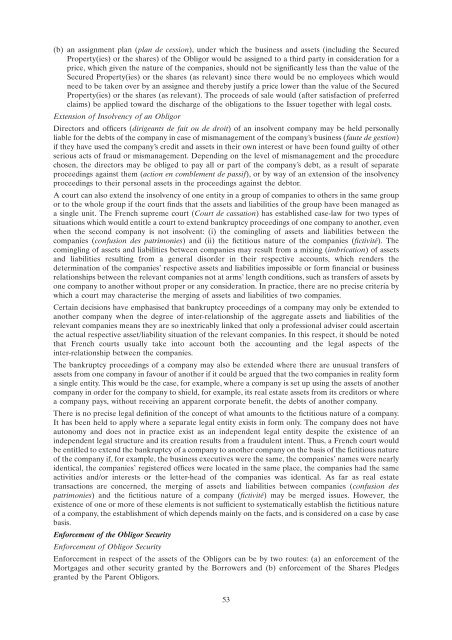FCC Proudreed Properties 2005 HSBC SG CORPORATE ...
FCC Proudreed Properties 2005 HSBC SG CORPORATE ...
FCC Proudreed Properties 2005 HSBC SG CORPORATE ...
Create successful ePaper yourself
Turn your PDF publications into a flip-book with our unique Google optimized e-Paper software.
(b) an assignment plan (plan de cession), under which the business and assets (including the Secured<br />
Property(ies) or the shares) of the Obligor would be assigned to a third party in consideration for a<br />
price, which given the nature of the companies, should not be significantly less than the value of the<br />
Secured Property(ies) or the shares (as relevant) since there would be no employees which would<br />
need to be taken over by an assignee and thereby justify a price lower than the value of the Secured<br />
Property(ies) or the shares (as relevant). The proceeds of sale would (after satisfaction of preferred<br />
claims) be applied toward the discharge of the obligations to the Issuer together with legal costs.<br />
Extension of Insolvency of an Obligor<br />
Directors and officers (dirigeants de fait ou de droit) of an insolvent company may be held personally<br />
liable for the debts of the company in case of mismanagement of the company’s business (faute de gestion)<br />
if they have used the company’s credit and assets in their own interest or have been found guilty of other<br />
serious acts of fraud or mismanagement. Depending on the level of mismanagement and the procedure<br />
chosen, the directors may be obliged to pay all or part of the company’s debt, as a result of separate<br />
proceedings against them (action en comblement de passif), or by way of an extension of the insolvency<br />
proceedings to their personal assets in the proceedings against the debtor.<br />
A court can also extend the insolvency of one entity in a group of companies to others in the same group<br />
or to the whole group if the court finds that the assets and liabilities of the group have been managed as<br />
a single unit. The French supreme court (Court de cassation) has established case-law for two types of<br />
situations which would entitle a court to extend bankruptcy proceedings of one company to another, even<br />
when the second company is not insolvent: (i) the comingling of assets and liabilities between the<br />
companies (confusion des patrimonies) and (ii) the fictitious nature of the companies (fictivité). The<br />
comingling of assets and liabilities between companies may result from a mixing (imbrication) of assets<br />
and liabilities resulting from a general disorder in their respective accounts, which renders the<br />
determination of the companies’ respective assets and liabilities impossible or form financial or business<br />
relationships between the relevant companies not at arms’ length conditions, such as transfers of assets by<br />
one company to another without proper or any consideration. In practice, there are no precise criteria by<br />
which a court may characterise the merging of assets and liabilities of two companies.<br />
Certain decisions have emphasised that bankruptcy proceedings of a company may only be extended to<br />
another company when the degree of inter-relationship of the aggregate assets and liabilities of the<br />
relevant companies means they are so inextricably linked that only a professional adviser could ascertain<br />
the actual respective asset/liability situation of the relevant companies. In this respect, it should be noted<br />
that French courts usually take into account both the accounting and the legal aspects of the<br />
inter-relationship between the companies.<br />
The bankruptcy proceedings of a company may also be extended where there are unusual transfers of<br />
assets from one company in favour of another if it could be argued that the two companies in reality form<br />
a single entity. This would be the case, for example, where a company is set up using the assets of another<br />
company in order for the company to shield, for example, its real estate assets from its creditors or where<br />
a company pays, without receiving an apparent corporate benefit, the debts of another company.<br />
There is no precise legal definition of the concept of what amounts to the fictitious nature of a company.<br />
It has been held to apply where a separate legal entity exists in form only. The company does not have<br />
autonomy and does not in practice exist as an independent legal entity despite the existence of an<br />
independent legal structure and its creation results from a fraudulent intent. Thus, a French court would<br />
be entitled to extend the bankruptcy of a company to another company on the basis of the fictitious nature<br />
of the company if, for example, the business executives were the same, the companies’ names were nearly<br />
identical, the companies’ registered offices were located in the same place, the companies had the same<br />
activities and/or interests or the letter-head of the companies was identical. As far as real estate<br />
transactions are concerned, the merging of assets and liabilities between companies (confusion des<br />
patrimonies) and the fictitious nature of a company (fictivité) may be merged issues. However, the<br />
existence of one or more of these elements is not sufficient to systematically establish the fictitious nature<br />
of a company, the establishment of which depends mainly on the facts, and is considered on a case by case<br />
basis.<br />
Enforcement of the Obligor Security<br />
Enforcement of Obligor Security<br />
Enforcement in respect of the assets of the Obligors can be by two routes: (a) an enforcement of the<br />
Mortgages and other security granted by the Borrowers and (b) enforcement of the Shares Pledges<br />
granted by the Parent Obligors.<br />
53

















